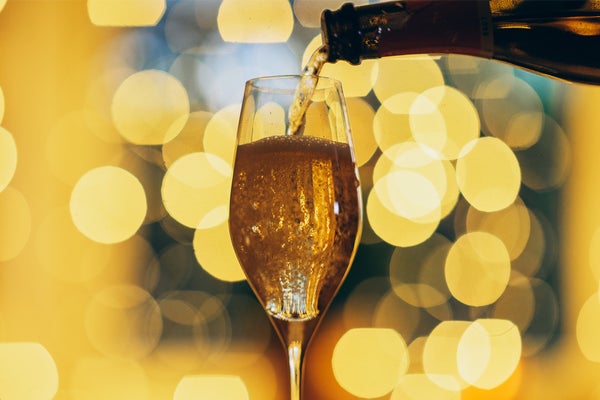’Tis the season, and it’s the most wonderful time of the year—but it’s also crammed with potential regrets packaged in the guise of festive alcoholic drinks served at countless holiday parties.
Fortunately, science can make navigating the minefield of holiday drinking a little easier—although it’s never consequence-free. Scientists aren’t, it turns out, hoarding away the secret recipe for a holiday punch that never punches back the next morning, as welcome as such a beverage would be. But they do have some tips to avoid overindulging.
“The number one thing on people’s minds usually is how to enjoy alcohol without the negative effects,” says Julia Chester, a neuroscientist at Purdue University who studies alcohol’s effects on the brain. “It’s like the holy grail.” Still, she says that understanding what makes alcohol so potent can help people avoid getting drunker than they mean to or suffering a painful hangover the day after.
How strongly alcohol affects an individual can depend on factors including their drinking history as well as genetic factors that influence the enzymes that break down alcohol in the body. But as tempting as it might be to blame a wild night on the power of, say, tequila, the specific type of alcohol a person drinks doesn’t strongly correlate with how intoxicated or hungover they end up, she says.
Instead an individual’s likelihood of becoming drunk or having a hangover is primarily determined by the total amount and speed of alcohol consumption. “How concentrated that drink is and how fast you’re drinking it are the primary determinants of the effects,” Chester says.
Certain ingredients or factors can affect how quickly you drink and absorb alcohol. Although some blame hangovers on chemicals called congeners, which are found in higher amounts in darker liquors such as whiskey, there’s not good evidence suggesting you’re any safer drinking vodka or gin. Some evidence suggests that carbonation speeds up alcohol absorption, whereas sugar—but not artificial sweeteners—slow it down, Chester says. But sweeter drinks mask the taste of alcohol, which can encourage faster consumption, she adds. And no amount of sugar can save you from a bad night’s drinking.
“I’d much rather be looking at the specific [amount of] alcohol of the drink on the label than I would on whether it had bubbles or not,” says Mark Bellis, a public health scientist at Liverpool John Moores University in England. Still, he notes that a drink’s characteristics can certainly affect one’s level of intoxication and hangover indirectly by influencing how much alcohol—and how quickly—they drink. For example, if someone considers champagne a treat, they may drink a New Year’s glass of bubbly more slowly than they would their usual favorite libation. Alternatively, they may find themselves accidentally becoming more drunk than they intended because they aren’t attuned to how their body processes champagne.
“People develop a tolerance to the levels of alcohol they’re consuming, and I think they also develop a familiarity with how that alcohol will affect them,” Bellis says. “There is something physiological about being used to drinking alcohol at certain levels, but also there’s something behavioral about understanding how a particular alcohol does affect you.”
Holiday drinking can also put people in unusual circumstances that can interfere with their ability to estimate how much they have consumed. For example, someone used to drinking cans of beer may be surprised by the amount of alcohol in a holiday party host’s generous pour of wine. “A lot of times you’re drinking more than you think you are,” Chester says.
Fortunately, alcohol consumption isn’t the only factor influencing the likelihood of intoxication and a hangover. The best ways to ward off these ill effects are to eat something before drinking and to stay hydrated while drinking, Chester says; she particularly recommends alternating between alcoholic beverages and water. Both eating food and staying hydrated slow the body’s absorption of alcohol and dampen its effects, although drinking will always come with a cost.
Those costs can come with a long delay. Although early alcohol guidelines focused on reducing the risk of alcoholism specifically, scientists have increasingly come to recognize alcohol’s carcinogenic nature and that even moderate drinking poses health risks.
The most immediate aftermath of drinking too much is, of course, a hangover. “The effects that alcohol induces in the body are dependent on the direction of change,” Bellis says. “As the alcohol recedes, even at the same levels, it doesn’t feel anywhere near as pleasurable as it did on the way up.”
Hangovers can include symptoms such as nausea, sensitivity to light and sound, and tiredness, among others. But the trademark symptom is a throbbing headache, likely triggered by dehydration. Some evidence also points to toxins released by alcohol metabolism, inflammation, low blood sugar and other factors.
A lucky handful of people—about 10 percent of the population—never experience a headache regardless of their drinking habits, says MaryAnn Mays, a neurologist at Cleveland Clinic’s Center for Headache and Pain. But for people with a history of migraine, a hangover may actually be a migraine in disguise, Mays says. In addition, alcoholic drinks may contain known migraine triggers such as sugar.
For most people, every alcoholic drink consumed contributes to the risk of a hangover. Despite the pain that hangovers cause people, there is still not a ton of research on how and why they occur, Bellis says. That’s likely because hungover people are perceived to be less of a burden to society compared with intoxicated people, he says, and because it’s harder to quantify the severity of hangovers than that of drunken benders.
Still, he hopes that this holiday season and throughout the year, moderating alcohol intake can give people more genuinely pleasant experiences. “Intuitively, people know that enjoyment of a night out just doesn’t keep going up and up and up the more you drink,” he says. Drinking a bit less and savoring a bit more, he says, “will give people a better time when they go out.”
